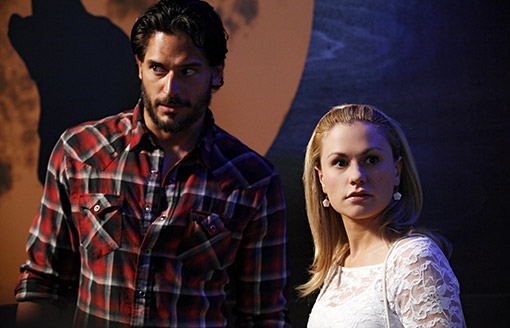Hot Blooded & Hairy
 Another season of True Blood is upon us! This season in particular has been so exciting, because we're getting into my favorite parts of the book series. (Club Dead & Dead to the World anyone?!)
Another season of True Blood is upon us! This season in particular has been so exciting, because we're getting into my favorite parts of the book series. (Club Dead & Dead to the World anyone?!)
Today, in honor of meeting Alcide and seeing Eclipse this week, I've got wolves on the brain. Let's discuss the school of thought on the Animal/spirit familiar-wolf-werewolf, shall we?
To begin, we should address the history of werewolves, either as hominid-proto wolves, or as a actual physical wolves. The Vault has done a great post on the history of werewolves, which I'll direct you to rather than rehash. Awesome job ladies :)
In regards to True Blood, Alan Ball has stayed true to the #1 rule of TrueBlood Universe -- the supernatural elements must abide by the rules of the natural world. That's why the vampire fangs are designed off of the cobra's, snapping back when not in use, and all shapeshifters take the complete form of the animal they turn into. Therefore, his werewolves will be taking the form of real Timberwolves, and not he proto-wolf-man we see in such classic Wolfman horror flicks, or morphing into giant wolves a la New Moon.
 Wolves have played an important role in Native American folklore, lending themselves well to Stephenie Meyer's own mythology throughout the Twilight books. In the Quileute legends mentioned, the wolves were larger than life, presumably because the original spirit-wolf housed both the wolf and the spirit of the man. (p249, Eclipse) From a writers perspective, I'd argue they were created that size to both intimidate humans and to be able to stand up to Meyer's indestructible vampires. This also adheres to the authors' ideas about supernatural creatures in Forks being driven more by magic than by the rules of real world physics.
Wolves have played an important role in Native American folklore, lending themselves well to Stephenie Meyer's own mythology throughout the Twilight books. In the Quileute legends mentioned, the wolves were larger than life, presumably because the original spirit-wolf housed both the wolf and the spirit of the man. (p249, Eclipse) From a writers perspective, I'd argue they were created that size to both intimidate humans and to be able to stand up to Meyer's indestructible vampires. This also adheres to the authors' ideas about supernatural creatures in Forks being driven more by magic than by the rules of real world physics.
This type of transformation speaks to the rules of shape-shifting rather than the traditional man-wolf tranformation. For example, neither Harris' or Meyer's werewolves are completely bound to the cycles of the moon. There's some interplay on the mythology which allows the transformation to take place at will. What's fun as a female viewer of this type of transformation as opposed to the proto-wolf-man transformation, is of course that the creature loses or shreds his clothing upon transforming. Speaking to the dual-nature of the werewolf, they only need clothing when living as a human and half of their life is in the form of an animal. The romantic implications here lend themselves to these men being protective, loyal and real animals in the bedroom (one can imagine... ;) Proceed with caution though, Shapeshifters are also wild animals, which could prove to be very dangerous for any brave tail-chaser or furbanger.

